The Papal Basilica of St. Paul Outside the Walls will open an ecumenical chapel where non-Catholic religions may perform their own liturgies and prayer services. The initiative is part of the Pauline year to begin in June, 2008. Sadly, the opening of the chapel has every indication of being part of Pope Benedict XVI’s ecumenical program that he urged upon his newly-created Cardinals in the consistories of both March 2006 and November 2007.
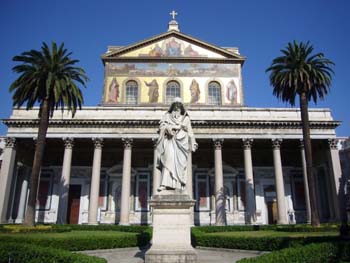
The Basilica will open a chapel for the prayer
and liturgy of the false religions |
One can rightly imagine how St. Maximilian Kolbe would react against this new program. In 1933, when the ecumenical movement began to get underway, St. Maximilian Kolbe saw it for what it was. He declared ecumenism as the enemy of the Blessed Virgin Mary; a movement to be opposed and destroyed.
The mission St. Maximilian entrusted to his Knights of the Immaculata was that of converting the whole world to the Catholic Church. He said, “Only until all Schismatics and Protestants profess the Catholic Creed with conviction, when all Jews voluntarily ask for Holy Baptism – only then will the Immaculata have reached its goals.” (1)
“In other words” St. Maximilian insisted, “there is no greater enemy of the Immaculata and her Knighthood than today’s ecumenism, which every Knight must not only fight against, but also neutralize through diametrically opposed action and ultimately destroy. We must realize the goal of the Militia Immaculata as quickly as possible: that is, to conquer the whole world, and every individual soul which exists today or will exist until the end of the world, for the Immaculata, and through her for the Most Sacred Heart of Jesus.” (2)
Fr. Edward Hanahoe, a superb theologian writing in the 1950s, pointed out a principal evil of the new ecumenism. He explained it has the effect of “perpetuating the state of separation, serving rather to keep people out of Church than to bring them into it.” (3)
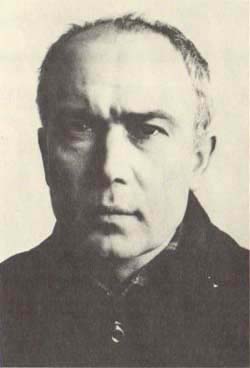
“Ecumenism is the enemy of the Immaculata” - Maximilian Kolbe |
A more perfect portrayal of post-Conciliar ecumenism could hardly be penned.
Those who promote the Council’s new ecumenism never remind the non-Catholic of the duty to convert to the Catholic Church for salvation. The true principle of conversion of non-Catholics is now replaced with a new principle of “convergence with non-Catholics.” (4) Thus, as Fr. Hanahoe warned, today’s ecumenism serves to perpetuate the state of separation of those outside the Church, rather than bring them into it. The ecumenism espoused by Catholics since the Council is actually a counterfeit model of unity adopted from the World Council of Churches (5) that implicitly denies the thrice-defined infallible doctrine: “Outside the Church there is no salvation.” (6)
Catholics the world over were thus scandalized to learn of the proposal to turn a section of the Papal Basilica of St. Paul Outside the Walls into an ecumenical chapel.
The Zenit report of December 21, 2007 read: “An ecumenical chapel at St. Paul Outside the Walls is one of the first initiatives of the upcoming Pauline Year. Cardinal Andrea Cordero Lanza di Montezemolo, archpriest of the papal basilica, announced plans for the chapel in an interview with L’Osservatore Romano (the Vatican’s official newspaper).”
The chapel, said Cardinal Lanza di Montezemolo, will offer the “possibility for non-Catholic Christian communities to come and pray at the basilica and to celebrate liturgy.”
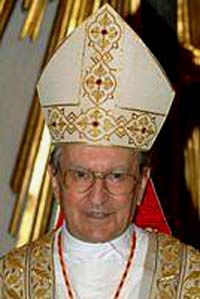
The Basilica's Archpriest Cardinal Lanza di Montezemolo confirms the opening of an ecumenical chapel |
According to Zenit, the Cardinal presented Benedict XVI with a program of the Pauline Year to be celebrated June 28, 2008 to June 29, 2009.
A month later, on January 21 2008, a Vatican Press conference was held in which Cardinal Lanza di Montezemolo, archpriest of the basilica, confirmed that the major Roman Basilica will open an “ecumenical chapel” in conjunction with the Pauline Year.
In an article on the press conference entitled “Strong Ecumenical Element of the Pauline Year,” Vatican Information Service reported, “Finally, the cardinal turned his attention to the ecumenical programme, ecumenism being an important aspect of the Pauline Year. He announced that the chapel currently used as the baptistery, located between the basilica and the cloister of St. Paul’s Outside the Walls, will become the ‘Ecumenical Chapel, maintaining its characteristic baptismal font but designated as a place in which to offer our Christian brethren a special place for prayer, either within their own groups, ... or together with Catholics, without the celebration of the Sacraments.’”
VIS continuted, “This chapel will also be used to house the remains of St. Timothy of Antioch and of other unknown 4th century martyrs.” (7)
The saddest aspect of this story is the fact that the Cardinal appears to follow the ecumenical program for the basilica and for the Pauline year sanctioned by Pope Benedict XVI himself. It is also in line with the ecumenical theme given at Pope Benedict’s two consistories of Cardinals.
A hermeneutic of ecumenical continuity
Pope Benedict XVI’s first Motu Proprio issued on May 31, 2005 was entitled “The Ancient and Venerable Basilica.” It clarified the canonical structure of the Major Basilica, St. Paul Outside the Walls.
Catholic World News reported, “In the Motu Proprio, Pope Benedict calls attention to the historical importance of St. Paul Outside the Walls, and especially the traditional connection to ecumenism. He encourages the continuation of that ecumenical unity in conjunction with the work of the Pontifical Council for Christian Unity.” (8)
Pope Benedict’s own words in the Motu Proprio on this point are as follows:
“In recent times, the Holy See has taken particular care to promote special ecumenical events in the Basilica or in the Abbey environment. It will therefore be the task of the Monks, under the supervision of the Archpriest, to organize, coordinate and develop such programs, also with the help of Benedictine confreres from other Abbeys and in accordance with the Pontifical Council for Promoting Christian Unity.” (9)
When Pope Benedict speaks of the ecumenical events connected with St. Paul Outside the Walls, he is perfectly correct.
- It was at St. Paul Outside the Walls in 1959 that Pope John XXIIII first announced his plan to convene the Second Vatican Council.
- It was at St. Paul Outside the walls where Pope Paul VI addressed the Protestant Observers at Vatican II assembled for a special “Liturgy of the Word” on December 4, 1965, marking the close of the Council. Here Paul VI told them, “Your departure compels us once again to thank you for your presence at our Ecumenical Council. We have appreciated it greatly, and we have felt its influence ... (10)
- St. Paul Outside the Walls was the place where in January 1986, Pope John Paul II publicly invited all the world religious leaders to participate in his pan-religious prayer for peace at Assisi, which was enacted in October, 1986. (11)
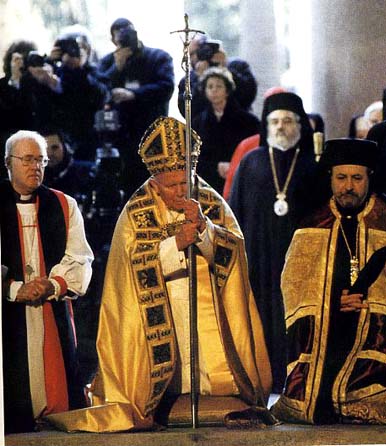
Breaking tradition, JPII opened the Holy Door
with a Schismatic and a Protestant |
- It was at St. Paul Outside the Walls where in January 2000, Pope John Paul opened the Holy Door of the basilica, marking the beginning of the Jubilee year. This was billed as “The Most Important Ecumenical Meeting since Vatican II,” comprising 200 delegations of ‘Christian Churches’ participating in the opening of the Holy Door, in addition to the World Council of Churches, which embraces 337 sects from over 100 countries. (12)
Pope John Paul II opened the Holy Door flanked by the ecumenical patriarch of Constantinople and the Anglican archbishop of Canterbury. (13) This was scandalous, as the opening of the Holy Door at a Holy Year by the Pope symbolizes the Pope’s power to open the gates of Heaven for mankind’s reception of sanctifying grace. When John Paul invited a Schismatic and a Protestant leader to join with him in this act of opening the Holy Door, he was teaching symbolically that non-Catholic religions are also channels of grace from Heaven.
- Each year, St. Paul Outside the Walls is the site of the concluding liturgy for the Week of Prayer for Christian Unity, a once-Catholic initiative that has become ecumenical since Vatican II, and now held in conjunction with the World Council of Churches.
- On January 21, 2007, Pope Benedict XVI invited the faithful to come celebrate ecumenical Vespers at this major basilica on January 25, 2007. He said, “I shall preside over Vespers celebrations in the Basilica of St. Paul Outside the Walls starting at 5:30 p.m.” (14) The ecumenical Vespers is the closing celebration of the Week of Christian Unity at which the Pope presides. Asia News reported Pope Benedict’s “ecumenical commitment to Christian unity,” in which “Benedict XVI stressed that such a commitment “is not limited to the experts but is for everyone.” The Pope said, “Ecumenism is a deep dialogical experience; it is listening and talking to one another, knowing each better. It is a task that everyone can accomplish, especially in terms of spiritual ecumenism based on prayer and sharing that are now possible between Christians.”(15)
Thus the establishment of the ecumenical chapel at St. Paul Outside the Walls conforms with the recent ecumenical history of the basilica, and follows Pope Benedict XVI’s request in his Motu Proprio “to promote special ecumenical events in the Basilica or in the Abbey environment.”
The Pauline Year
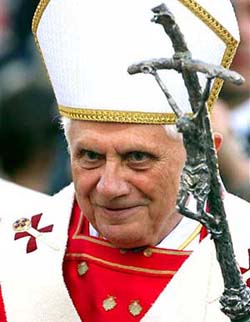
Benedict XVI announces the jubilee year of St. Paul will be characterized by ecumenism |
Pope Benedict XVI likewise encourages ecumenical events for the upcoming Pauline Year.
On June 28, 2007, the Pope officially announced the special jubilee year of the Apostle Paul from June 28, 2008 to June 29, 2009, for the occasion of the 2,000th anniversary of his birth, “which historians place between 7 and 10". The Vatican Information Service subtitled its report on the event, “The Pauline Year will be Characterized by Ecumenism.”
VIS reported, “The Pope went on to explain that this ‘Pauline Year’ will be celebrated particularly in Rome, and that basilica of St. Paul Outside the Walls will host ‘a series of liturgical, cultural and ecumenical events,’ as well as ‘pastoral and social initiatives.’”
It should be noted that Pope Benedict XVI’s call for ecumenical events for the Pauline Year was issued a mere nine days before the release of his July 7 Motu Proprio on the Latin Mass.
VIS continued, “The Holy Father highlighted the fact that the Pauline Year will be characterized by its ‘ecumenical dimension’ because “the Apostle of the Gentiles, particularly dedicated to bringing the Good News to all people, concerned himself with the unity and harmony of all Christians.”(17)
Thus the proposal for the ecumenical chapel by Cardinal Lanza di Montezemolo, archpriest of the papal basilica, should come as no surprise, especially since in both consistories of Pope Benedict XVI, the newly-created Cardinals were encouraged to keep ecumenism central to their mission.
Read also Part II of this article
1. Rycerz Niopokalenz, 4 (1922), p. 78. Cited from Father Karl Stehlin, The Immaculata Our Ideal, [Warsaw: Te Deum, 2005], p.37.
2. Entry of Diary dated April 23, 1933. Cited from The Immaculata Our Ideal, p. 37.
3. One Fold: Essays and Documents to Commemorate the Golden Jubilee of the Chair of Unity Octive, 1908-1958 edited by Edward F. Hanahoe, S.A., S.T.D., and Titus F. Cranny, S.A., S.T.D., M.A. [Graymoor: Chair of Unity Apostolate, 1959], p. 121.
4. For a fuller treatment of this, see J. Vennari, “Vatican II vs. the Unity Willed by Christ”, Catholic Family News, Aug. 2005. Reprint 2023 available for $2.00 postpaid from CFN. On the web at www.cfnews.org/V2-unity.htm
5. This is explained more completely in the DVD: “Vatican II: The Best Council the Protestants Ever Had”. J. Vennari (Available for $12.95 postpaid from Oltyn Library Services, 2316 Delaware Ave, PMB 325, Buffalo NY 14216. Also available on the web at www.cfnews.org/V2-BestCouncil.htm
6. “The Most Holy Roman Church firmly believes, professes and preaches that none of those existing outside the Catholic Church, not only pagans, but also Jews, heretics, and schismatics can ever be partakers of eternal life, but that they are to go into the eternal fire 'which was prepared for the devil and his angels,' (Mt. 25:41) unless before death they are joined with Her; and that so important is the unity of this Ecclesiastical Body, that only those remaining within this unity can profit from the sacraments of the Church unto salvation, and that they alone can receive an eternal recompense for their fasts, almsdeeds, and other works of Christian piety and duties of a Christian soldier. No one, let his almsgiving be as great as it may, no one, even if he pour out his blood for the Name of Christ, can be saved unless they abide within the bosom and unity of the Catholic Church.” Pope Eugene IV, Council of Florence, Feb. 4, 1442.
7. See “Papal Basilica to Open Ecumenical Chapel”, Zenit, December 21, 2007; and “Strong Ecumenical Element of Pauline Year”, Vatican Information Service, January 21, 2008. On the web at: http://212.77.1.245/news_services/press/vis/dinamiche/a10_en.htm
8. “Papal Document Clarifies Role of Roman Basilica”, Catholic World News, May 31, 2005.
9. Motu Proprio, “The Ancient and Venerable Basilica”, May 31, 2005. (#9) Vatican webpage: www.vatican.va/holy_father/benedict_xvi/motu_proprio/documents/hf_ben-xvi_motu-proprio_20050531_antica-venerabile-basilica_en.html
10. Augustine Cardinal Bea, The Way to Unity After the Council, [New York: Hereder, 1967], p. 10-11.
11. “John Paul Invites All People to Join in Prayer for Peace”, Associated Press, Jan. 25, 1986.
12. “Most Important Ecumenical Meeting Since Vatican Council II: Opening Holy Doors of St. Paul Outside the Walls”, Zenit, January 14, 2000.
13. “Papal Document Clarifies Role of Roman Basilica”, Catholic World News, May 31, 2005.
14. “Ecumenism, Prayer are Everybody’s Responsibility, Says Pope”, Asia News, Jan. 21, 2007. This was the same speech in which he called on children to throw away toy guns.
15. Ibid.
16. See Vatican Webpage: “Resources for the Week of Christian Unity”, Jan. 2008: http://www.vatican.va/roman_curia/pontifical_councils/chrstuni/weeks-prayer-doc/rc_pc_chrstuni_doc_20070710_week-prayer-2008_en.html
17. “The Holy Father Proclaims a Year Dedicated to St. Paul”, Vatican Information Service, June 28, 2007.

Posted January 24, 2007
|
